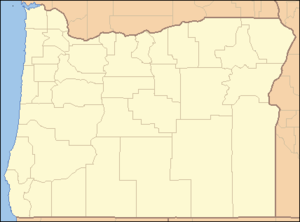North Santiam River
| North Santiam River | |
|
North Santiam River at Niagara County Park
|
|
| Name origin: Kalapuya tribe that lived near the Santiam River until removal to the Grande Ronde Reservation in 1906 | |
| Country | United States |
|---|---|
| State | Oregon |
| County | Linn and Marion |
| Source | Santiam Lake |
| - location | Cascade Range, Mount Jefferson Wilderness, Linn County |
| - elevation | 5,133 ft (1,565 m) |
| - coordinates | 44°28′39″N 121°53′04″W / 44.47750°N 121.88444°W |
| Mouth | Santiam River |
| - location | Willamette Valley, Marion County |
| - elevation | 217 ft (66 m) |
| - coordinates | 44°41′12″N 123°00′24″W / 44.68667°N 123.00667°WCoordinates: 44°41′12″N 123°00′24″W / 44.68667°N 123.00667°W |
| Length | 92 mi (148 km) |
| Basin | 766 sq mi (1,984 km2) |
| Discharge | for Mehama, 38.7 miles (62.3 km) from the mouth |
| - average | 3,371 cu ft/s (95 m3/s) |
| - max | 76,600 cu ft/s (2,169 m3/s) |
| - min | 420 cu ft/s (12 m3/s) |
The North Santiam River is a 92-mile (148 km) tributary of the Santiam River in western Oregon in the United States. It drains 766 square miles (1,980 km2) of the Cascade Range on the eastern side of the Willamette Valley east of Salem.
It rises in the high Cascades in eastern Linn county, northwest of Three Fingered Jack in the Willamette National Forest. It flows north through the mountains past Marion Forks, receiving the drainage from the western slope of Mount Jefferson. Near Mount Jefferson it turns sharply west, descending through a canyon past Idanha and Detroit to Niagara County Park where the valley begins to widen and some agriculture use begins. Continuing west, the river flows past Gates, Mill City and Mehama. It emerges through the foothills into the Willamette Valley near Stayton, then flows 15 miles (24 km) southwest through the valley where it joins the South Santiam River to form the Santiam River. The confluence is approximately 10 miles (16 km) east of the confluence of the Santiam and the Willamette River.
It is impounded by Detroit Dam in the mountains west of Detroit to form Detroit Lake for flood control. Detroit Lake State Park is along the northern shore of the lake.
...
Wikipedia


